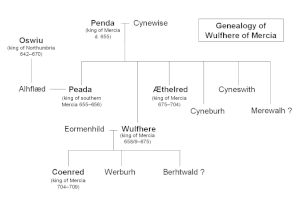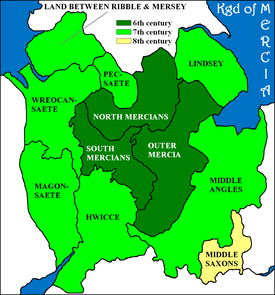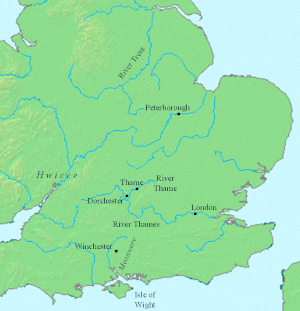Wulfhere of Mercia
| Wulfhere | |
|---|---|
Penda | |
| Mother | Cynewise (possibly) |
Wulfhere or Wulfar (died 675) was
Wulfhere's father,
By 670, when Oswiu died, Wulfhere was the most powerful king in southern England. He was effectively the overlord of England south of the Humber from the early 660s, although not overlord of Northumbria as his father had been. In 674, he challenged Oswiu's son Ecgfrith of Northumbria, but was defeated. He died, probably of disease, in 675. Wulfhere was succeeded as King of Mercia by his brother, Æthelred. Stephen of Ripon's Life of Wilfrid describes Wulfhere as "a man of proud mind, and insatiable will".[1]
Mercia in the 7th century

England in AD 600 was ruled almost entirely by the
According to Bede's Historia ecclesiastica gentis Anglorum, a history of the English church, there were seven early Anglo-Saxon rulers who held imperium, or overlordship, over the other kingdoms.[5] The fifth of these was Edwin of Northumbria, who was killed at the Battle of Hatfield Chase by a combined force including Cadwallon, a British king of Gwynedd and Penda. At the time of this victory, Penda was probably not yet king of Mercia. His children included two future kings of Mercia: Wulfhere and Æthelred.[6]
After Edwin's death, Northumbria briefly fell apart into its two constituent kingdoms -
The main source for this period is Bede's History, completed in about 731. Despite its focus on the history of the church, this work also provides valuable information about the early pagan kingdoms. For other kingdoms than his native Northumbria, such as Wessex and Kent, Bede had an informant within the ecclesiastical establishment who supplied him with additional information. This does not seem to have been the case with Mercia, about which Bede is less informative than about other kingdoms.[11] Further sources for this period include the Anglo-Saxon Chronicle, compiled at the end of the 9th century in Wessex. The Chronicle's anonymous scribe appears to have incorporated much information recorded in earlier periods.[12]
Ancestry

Wulfhere was the son of Penda of Mercia. Penda's queen, Cynewise, is named by Bede, who does not mention her children; no other wives of Penda are known and so it is likely but not certain that she was Wulfhere's mother.[13][14] The Anglo-Saxon Chronicle gives Penda's age as fifty in 626, and credits him with a thirty-year reign, but this would put Penda at eighty years old at the time of his death, which is generally thought unlikely as two of his sons (Wulfhere and Æthelred) are recorded as being young when he was killed. It is thought at least as likely that Penda was 50 years old at his death, rather than at his accession.[6][15] Wulfhere's date of birth is unknown, but Bede describes him as a youth at the time of his accession in 658, so it is likely he was in his middle teens at that time; Penda would then have been in his thirties at the time Wulfhere was born.[16]
Nothing is known of Wulfhere's childhood. He had two brothers, Peada and Æthelred, and two sisters, Cyneburh and Cyneswith;
Accession and overlordship

In 655 Penda besieged Oswiu of Northumbria at Iudeu, the location of which is unknown but which may have been
Peada did not remain king long. He was murdered at
How much direct control Oswiu exerted over the southern kingdoms during his imperium is unclear. Bede describes Oswiu's friendship and influence over
A document called the Tribal Hidage may date from Wulfhere's reign. Drawn up before many smaller groups of peoples were absorbed into the larger kingdoms, such as Mercia, it records the peoples of Anglo-Saxon England, along with an assessment in hides, a unit of land. The Tribal Hidage is difficult to date precisely; it may have been written down in Wulfhere's reign, but other suggested origins include the reign of Offa of Mercia, or Edwin or Oswiu of Northumbria.[34][35]
A convert king

Britain had been Christianised
Wulfhere's relationship with Bishop Wilfrid is recorded in Stephen of Ripon's Life of Wilfrid. During the years 667–69, while Wilfrid was at Ripon, Wulfhere frequently invited him to come to Mercia when there was need of the services of a bishop. According to Stephen, Wulfhere rewarded Wilfrid with "many tracts of land", in which Wilfrid "soon established minsters for servants of God".[44]
According to the Anglo-Saxon Chronicle, Wulfhere endowed a major monastery at
West Saxons, South Saxons and Hwicce

In 661, Wulfhere is recorded in the Chronicle as harrying Ashdown, in West Saxon territory. The Gewisse, thought to be the original group from which the West Saxons came, appear to have originally settled in the upper Thames valley, and what records survive of the 6th century show them active in that region. The Mercian resurgence under Wulfhere placed them under severe pressure. Also in the early 660s, the West Saxon see of Dorchester, in the same area, was divided, and a new bishopric set up at Winchester. This decision was probably a reaction to the advance of the Mercians into the traditional heartland of the West Saxons, leaving Dorchester dangerously close to the border. Within a few years, the Dorchester see was abandoned;[46] the exact date is not known, but it was probably in the mid 660s.[47]
In addition to the attack on Ashdown, Wulfhere raided the Isle of Wight in 661. He subsequently gave both the island and the territory of the Meonware, which lay along the river Meon, on the mainland north of the Isle of Wight, to his godson King Æthelwealh of the South Saxons. It seems likely that the ruling dynasty on the island found these arrangements acceptable to some degree, since the West Saxons, under Cædwalla, exterminated the whole family when they launched their own attack on the island in 686.[48][49] After the conquest of the Isle of Wight, Wulfhere ordered the priest Eoppa to provide baptism to the inhabitants. According to the Chronicle, this was the first time Christian baptism had reached the island.[50]
In the early 670s,
In addition to being Wulfhere's godson, King Æthelwealh of the South Saxons had a connection to the Mercians via marriage. His wife was Queen Eafe, the daughter of Eanfrith of the Hwicce, a tribe whose territory lay to the southwest of Mercia. The Hwicce had their own royal family, but it appears that at this date they were already subordinate to Wulfhere: the marriage between Æthelwealh and Eafe may well have taken place at Wulfhere's court, since it is known Æthelwealh was converted there.[53] The kingdom of the Hwicce is sometimes regarded as a creation of Penda's, but it is equally likely that the kingdom existed independently of Mercia, and that Penda and Wulfhere's increasing influence in the area represented an extension of Mercian power rather than the creation of a separate entity.[54][55]
East Anglia and the East Saxons
In 664,
It is apparent from these events that Oswiu's influence in the south had waned by this time, if not before, and that Wulfhere now dominated the area. This becomes even clearer in the next few years, as some time between 665 and 668 Wulfhere sold the see of
Kent, Surrey and Lindsey
Eorcenberht was the king of Kent at Wulfhere's accession, and the two families became connected when Wulfhere married Eorcenberht's daughter Eormenhild.[58] In 664 Eorcenberht's son Egbert succeeded to the Kentish throne. The situation in Kent at Egbert's death in 673 is not clearly recorded. It appears that a year passed before Hlothhere, Egbert's brother, became king. Wulfhere may have had an interest in the succession, as through his marriage to Eormenhild he was the uncle of Egbert's two sons, Eadric and Wihtred. It has been speculated that Wulfhere acted as the effective ruler of Kent in the interregnum between Egbert's death and Hlothhere's accession.[49] Another Mercian connection to Kent was through Merewalh, the king of the Magonsæte, and hence a subking under Wulfhere. Merewalh, who may have been Wulfhere's brother, was married to Hlothhere's sister, Eormenburh.[19]
Wulfhere's influence among the Lindesfara, whose territory, Lindsey, lay in what is now Lincolnshire, is known from information about episcopal authority. At least one of the Mercian bishops of Lichfield is known to have exercised authority there: Wynfrith, who became bishop on Chad's death in 672.[42][59] In addition it is known that Wulfhere gave land at Barrow upon Humber, in Lindsey, to Chad, for a monastery.[61] It is possible that Chad also had authority there as bishop, probably no later than 669.[42] It may be that the political basis for Mercian episcopal control of the Lindesfara was laid early in Wulfhere's reign, under Trumhere and Jaruman, the two bishops who preceded Chad.[42]
Defeat and death
When Wulfhere attacked Oswiu's son Ecgfrith in 674, he did so from a position of strength. Stephen of Ripon's Life of Wilfrid says that Wulfhere "stirred up all the southern nations against [Northumbria]". Bede does not report the fighting, nor is it mentioned in the Anglo-Saxon Chronicle, but according to Stephen, Ecgfrith defeated Wulfhere, forcing him to surrender Lindsey, and to pay tribute.[62]
Wulfhere survived the defeat but evidently lost some degree of control over the south as a result; in 675, Æscwine, one of the kings of the West Saxons, fought him at Biedanheafde. It is not known where this battle was, or who was the victor. Henry of Huntingdon, a 12th-century historian who had access to versions of the Anglo-Saxon Chronicle now lost,[63] believed that Mercians had been the victors in a "terrible battle" and remarks upon Wulfhere having inherited "the valour of his father and grandfather".[64] Kirby, however, presumes Æscwine was sufficiently successful to break Wulfhere's hold over Wessex.[65]
Wulfhere died later in 675. The cause of death, according to Henry of Huntingdon, was disease.[64] He would have been in his mid-thirties. His widow, Eormenhild, is thought to have later become the abbess of Ely.[66] Æthelred, Wulfhere's brother, succeeded to the throne and reigned for nearly thirty years. Æthelred recovered Lindsey from the Northumbrians a few years after his accession, but he was generally unable to maintain the domination of the south achieved by Wulfhere.[65]
Marriage and children
At an unrecorded date Wulfhere married
- Coenred, King of Mercia from 704 to 709, is recorded in John of Worcester's 12th-century chronicle as Wulfhere's son.[20]
- Berhtwald, a sub-king who is recorded as a nephew of Æthelred,[21]
- Werburh (alias Werburga, etc.), recorded in an 11th-century manuscript as a daughter of Wulfhere.[22]
- Saint Chad, was converted by that saint to Christianity. This caused great displeasure of his father, who had relapsed to paganry, and slew both his sons for their actions. Wulfad was slain by his father at Stone, in Staffordshire, and Ruffin at Burston. Their mother founded Stone Priory on the spot of the burial of both her sons.[67]
- Ruffin, slain by his father at Burston, for having converted to Christianity.
References
- ^ Colgrave, Life of Bishop Wilfred, c. 20.
- ^ Bede, HE, I, 15, p. 63.
- ^ Yorke, Barbara, "The Origins of Mercia" in Brown and Farr, Mercia, pp. 15–16
- ^ Barbara Yorke, "The Origins of Mercia" in Brown and Farr, Mercia, pp. 18–19
- ^ a b Bede, HE, II, 5, p. 111.
- ^ a b Yorke, Kings and Kingdoms, pp. 103–4
- ^ Kirby, Earliest English Kings, p. 83.
- ^ Kirby, Earliest English Kings, pp. 88–90
- ^ Yorke, Kings and Kingdoms, p. 105
- ^ Yorke, Kings and Kingdoms, p. 78
- ^ Yorke, Kings and Kingdoms, p. 100
- ^ Simon Keynes, "Anglo-Saxon Chronicle", in Blackwell Encyclopedia, p. 35
- ^ Stafford, Pauline, "Political Women in Mercia" in Brown and Farr, Mercia, p. 36
- ^ a b Bede, HE, III, 24, pp. 183–5.
- ^ Kirby, Earliest English Kings, p. 82.
- ^ Kirby, Earliest English Kings, p. 113
- ^ Kirby, Earliest English Kings, p. 93
- ^ Swanton, Anglo-Saxon Chronicle, sub anno 656, p. 29
- ^ a b Yorke, p. 107, accepts the account in the Life of St Mildburh, which makes Merewalh and Wulfhere brothers, as genuine. Kirby, p. 93, expresses doubts.
- ^ a b Kirby, Earliest English Kings, p. 128
- ^ a b Yorke, Kings and Kingdoms, p. 108
- ^ a b Jane Roberts, "Hagiography and Literature: The Case of Guthlac of Crowland" in Brown and Farr, Mercia, p. 84
- ^ For details see Baker and Holt, Urban Growth, p. 18. The history is the Historia et Cartularium Monasterii Sancti Petri Gloucesteriæ, which incorporates material from as early as the late 11th century.
- ^ See Higham, English Empire, p. 149, figure 7; M. Lapidge (ed.), p. 517, map 9; Zaluckyj, Mercia, p. 16
- River Don, has been suggested as a candidate; see e.g. Kirby, Earliest English Kings, pp. 94–95; other suggestions include an unspecified tributary of the Humber; see e.g. Swanton, Anglo-Saxon Chronicle, p. 29 n. 11.
- ^ Kirby, Earliest English Kings, pp. 94–95
- ^ a b Kirby, Earliest English Kings, pp.96–7
- ^ Kirby, Earliest English Kings, p. 96; Bede, HE, III, 24.
- ^ Bede, HE, III, 25; p. 183.
- ^ Higham, Convert Kings, p. 245.
- ^ Bede, HE III, 22, p. 178.
- ^ a b Kirby, Earliest English Kings, pp. 114–5
- ^ See, for example, Higham, Convert Kings, pp. 249&–50; Keynes; Yorke, pp. 157–9; Williams, Kingship and Government, pp. 20–3.
- ^ Higham, English Empire, p. 99.
- ^ Peter Featherstone, "The Tribal Hidage and the Ealdormen of Mercia" in Brown and Farr, Mercia, p. 29
- ^ Campbell, "The First Christian Kings", in Campbell, The Anglo-Saxons, pp. 45–6.
- ^ Kirby, The Earliest English Kings, pp. 48–50.
- ^ Kirby, The Earliest English Kings, p. 78.
- ^ Kirby, The Earliest English Kings, p. 118.
- ^ Higham, Convert Kings, p. 68.
- ^ Bede, HE, III, 21, pp. 177–8.
- ^ a b c d e Kirby, The Earliest English Kings, p. 114.
- ^ Zaluckyj, Mercia, p. 37.
- ^ Blair, The Church in Anglo-Saxon Society, p. 92.
- ^ Anglo-Saxon Chronicle, sub anno 656; Zaluckyj, p. 38.
- ^ Yorke, Kings and Kingdoms, p. 136.
- ^ Kirby, The Earliest English Kings, pp. 58–9.
- ^ Bede, HE, IV, 13, pp. 225–7.
- ^ a b c Kirby, Earliest English Kings, pp. 115&–6
- ^ Swanton, Anglo-Saxon Chronicle, sub anno 661, pp. 33–4.
- ^ Kirby, The Earliest English Kings, pp. 52–3.
- ^ For the situation at Wulfhere's death, see Kirby, The Earliest English Kings, pp.& 115–6; for Cædwalla see Kirby, The Earliest English Kings, pp. 118–21.
- ^ Kirby, The Earliest English Kings, pp. 11–12.
- ^ Kirby, The Earliest English Kings, pp. 8–9.
- ^ Yorke, Kings and Kingdoms, pp. 108–9.
- ^ Bede, HE, III, 30, pp. 200–1.
- ^ Robert Cowie, "Mercian London" in Brown and Farr, Mercia, pp. 198–9
- ^ Kirby, Earliest English Kings, p. 43
- ^ a b c Williams, Kingship and Government p. 21.
- ^ Whitelock, English Historical Documents, p. 440.
- ^ Simon Keynes, "Wulfhere", in Blackwell Encyclopedia, p. 490
- ^ Colgrave, Life of Bishop Wilfred, c. 20; Kirby, Earliest English Kings, p. 116; Williams, Kingship and Government, p. 23.
- ^ Diana E. Greenway, "Henry of Huntingdon", in Lapidge et al., Blackwell Encyclopedia of Anglo-Saxon England, pp. 232–3.
- ^ a b Henry of Huntingdon, sub anno 670.
- ^ a b Kirby, Earliest English Kings, pp. 116–7.
- ^ a b Yorke, Kings and Kingdoms, p. 70.
- ^ Cope, Norman A., Stone: The History of a Market Town, pp.7-8,[1] quoting sources on p.10, note 5, including Dugdale, Monasticon, Vol.6, Part 1, "an account in a Peterborough book written c.970 AD"; Inscription on a tablet hanging at Stone Priory at the Dissolution, recorded by Dugdale; Henry Bradshaw, Life of Saint Werburga of Chester; Beresford, Memories of Old Staffordshire; Warner, R.H., Life and Legends of saint Chad
Sources
Primary sources
- ISBN 0-14-044565-X
- Colgrave, Bertram (1927). The Life of Bishop Wilfred by Eddius Stephanus. London: Cambridge University Press.
- Forrester, Thomas (1991). The Chronicle of Henry of Huntingdon. Felinfach: Llanerch Press. ISBN 0-947992-55-3.
- Swanton, Michael (1996). The Anglo-Saxon Chronicle. New York: Routledge. ISBN 0-415-92129-5.
- Whitelock, Dorothy (1968). English Historical Documents v.l. c.500–1042. London: Eyre & Spottiswoode.
Secondary sources
- Baker, Nigel; Holt, Richard (2004). Urban Growth and the Medieval Church: Gloucester and Worcester. Gloucester: Ashgate. ISBN 0-7546-0266-4.
- Blair, John (2006). The Church in Anglo-Saxon Society. Oxford: Oxford University Press. ISBN 0-19-921117-5.
- Campbell, John (1991). "The First Christian Kings". In Campbell, James; et al. (eds.). The Anglo-Saxons. Penguin Books. ISBN 0-14-014395-5.
- Featherstone, Peter (2001). "The Tribal Hidage and the Ealdormen of Mercia". In Michelle Brown; Carole Farr (eds.). Mercia: An Anglo-Saxon Kingdom in Europe. Leicester: Continuum. ISBN 0-8264-7765-8.
- Higham, N. J. (1993). An English Empire: Bede and the early Anglo-Saxon kings. Manchester: Manchester University Press. ISBN 0-7190-4424-3.
- Higham, N. J. (1997). The Convert Kings: Power and religious affiliation in early Anglo-Saxon England. Manchester: Manchester University Press. ISBN 0-7190-4828-1.
- ISBN 0-631-22492-0.
- Kirby, D.P. (1992). The Earliest English Kings. London: Routledge. ISBN 0-415-09086-5.
- Williams, Ann (1999). Kingship and Government in Pre-Conquest England, c. 500–1066. Basingstoke: Macmillan. ISBN 0-333-56798-6.
- Yorke, Barbara (1990). Kings and Kingdoms of Early Anglo-Saxon England. London: Seaby. ISBN 1-85264-027-8.
- Zaluckyj, Sarah (20 October 2001). Mercia: The Anglo-Saxon Kingdom of Central England. Logaston: Logaston Press. ISBN 1-873827-62-8.
External links

